An Impulse Dynamic Model for Computer Worms
Abstract
A worm spread model concerning impulsive control strategy is proposed and analyzed. We prove that there exists a globally attractive virus-free periodic solution when the vaccination rate is larger than θ1. Moreover, we show that the system is uniformly persistent if the vaccination rate is less than θ1. Some numerical simulations are also given to illustrate our main results.
1. Introduction
Computer virus is a kind of computer program that can replicate itself and spread from one computer to others including viruses, worms, and trojan horses. Worms use system vulnerability to search and attack computers. As hardware and software technologies develop and computer networks become an essential tool for daily life, worms start to be a major threat. In June 2010, the Belarusian security firm Virus Block Ada discovered deadly Stuxnet worm. The Stuxnet worm is the first known example of a cyber-weapon that is designed not just to steal and manipulate data but to attack a processing system and cause physical damage. The Stuxnet worm is the first cyber-attack of its kind and has infected thousands of computer systems worldwide.
Consequently, the trial on better understanding the worm propagation dynamics is an important matter for improving the safety and reliability in computer systems and networks. Similar to the biological viruses, there are two ways to study this problem: microscopic and macroscopic. Following a macroscopic approach, since [1, 2] took the first step towards modeling the spread behavior of worms, much effort has been done in the area of developing a mathematical model for the worms propagation [3–13]. These models provide a reasonable qualitative understanding of the conditions under which viruses spread much faster than others and why.
In [7], the authors investigated a differential SEIR model by making the following assumptions (Figure 1).
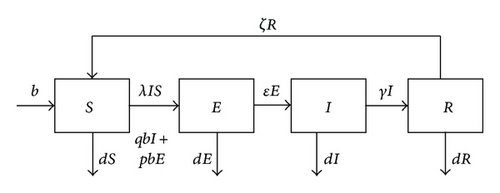
A population size N(t), that is, the total nodes at any time t in the computer network, is partitioned into subclasses of nodes which are susceptible, exposed (infected but not yet infectious), infectious, and recovered with sizes denoted by S(t), E(t), I(t), and R(t), respectively.
In the SEIRS model, the flow is from class S to class E, class E to class I, class I to class R, and again class R to class S. For the vertical transformation, we assume that a fraction p and a fraction q of the new nodes from the exposed and the infectious classes, respectively, are introduced into the exposed class E. Consequently, the birth flux into the exposed class is given by pbE + qbI, and the birth flux into the susceptible class is given by b − pbE − qbI.
As we know, antivirus software is a kind of computer program which can detect and eliminate known worm. There are two common methods to detect worms: using a list of worm signature definition and using a heuristic algorithm to find worm based on common behaviors. It has been observed that it does not always work in detecting a novel worm by using the heuristic algorithm. On the other hand, obviously, it is impossible for antivirus software to find a new worm signature definition on the dated list. So, to keep the antivirus software in high efficiency, it is important to ensure that it is updated. Based on the previous facts, we propose an impulsive system to model the process of periodic installing or updating antivirus software on susceptible computers at fixed time for controlling the spread of worm.
Based on the previous facts, we propose the following assumptions:
- (H1)
the antivirus software is installed or updated at time t = kτ(k ∈ N), where τ is the period of the impulsive effect;
- (H2)
S computers are successfully vaccinated from S class to R class with rate (0 < θ < 1).
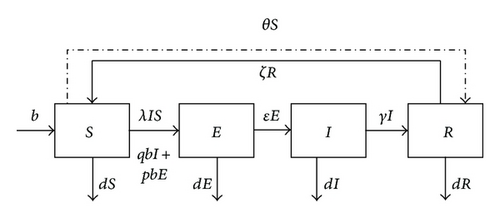
The organization of this paper is as follows. In Section 2, we establish sufficient condition for the local and global attractivity of virus-free periodic solution. The sufficient condition for the permanence of the model is obtained in Section 3. Some numerical simulations are performed in Section 4. In the final section, a brief conclusion is given, and some future research directions are also pointed out.
2. Global Attractivity of Virus-Free Periodic Solution
To prove our main results, we state three lemmas which will be essential to our proofs.
Lemma 1 (see [14].)Consider the following impulsive differential equations:
Theorem 2. Let (S(t), E(t), I(t), N(t)) be any solution of system (6) with initial values S(0+) > 0, E(0+) > 0, I(0+) > 0, and N(0+) > 0; then is locally asymptotically stable, provided that pb − d − ε < 0 and R0 < 1, where
Proof. The local stability of virus-free periodic solution may be determined by considering the behaviors of a small amplitude perturbation of the solution. Define , x(t) = E(t), y(t) = I(t), and z(t) = N(t) − b/d, and then the linearized system of system (6) reads as
The proof is complete.
Theorem 3. If R1 ≤ 1, and pb − d − ε < 0 then is globally asymptotically stable for system (11), where
Proof. Because ex − 1 > x, for x > 0, we have
Let
The proof is complete.
Corollary 4. The virus-free periodic solution of system (6) is globally attractive, if θ > θ1, where θ1 = 1 − e(ζ+d)τ + εbλ(e(ζ+d)τ − 1)/d[(d + ε − pb)(r + d + η) − εqb].
Theorem 2 determines the global attractivity of (6) in Ω for the case R0 < 1. Its realistic implication is that the infected computers vanish, so the worms are removed from the network. Corollary 4 implies that the computer virus will disappear if the vaccination rate is less than θ1.
3. Permanence
In this section, we say that the worm is local if the infected population persists above a certain positive level for sufficiently large time. The local of worm can be well captured and studied through the notion of permanence.
Definition 5. System (6) is said to be uniformly persistent if there is an φ > 0 (independent of the initial data) such that every solution (S(t), I(t), R(t), N(t)) with initial conditions (8) of system (6) satisfies
Theorem 6. Suppose that R1 > 1 and pb − d − ε < 0. Then there is a positive constant mI such that each positive solution (S(t), E(t), I(t), R(t)) of system (6) satisfies I(t) ≥ mI, for t large enough.
Proof. Now, we will prove that there exist mI > 0 and a sufficiently large tp such that I(t) ≥ mI holds for all t > tp. Suppose that I(t) < I* for all t > t0. From the forth equation of (6), we have
By Lemma 1, we know that there exists t1 > t0 such that
Therefore, it is certain that there exists a η (0 < η < τ, and η is independent of the choice of t2) such that
Case 1. If ξ ≤ η < τ, then it is obvious that I(t) ≥ I*/2, for t ∈ [t2, t2 + ξ].
Case 2. If η < ξ ≤ τ, then from the second equation of system (6), we obtain .
Since I(t2) = I*, it is obvious that , for t ∈ [t2, t2 + ξ].
Case 3. If η < τ ≤ ξ, it is easy to obtain that I(t) > I** for t ∈ [t2, t2 + τ]. Then, proceeding exactly as the proof for the previous claim, we have that I(t) > I** for t ∈ [t2 + τ, t2 + ξ].
Owing to the randomicity of t2, we can obtain that there exists such I(t) > mI holds for all t > tp.
The proof of Theorem 6 is completed.
Theorem 7. Suppose R1 > 1. Then system (6) is permanent.
Proof. Let (S(t), E(t), I(t), N(t)) be any solution of system (6). First, from the first equation of system (6), we have
The proof of Theorem 7 is completed.
4. Numerical Simulations
In this section we have performed some numerical simulations to show the geometric impression of our results.
To demonstrate the global attractivity of virus-free periodic solution of system (6), we take following set parameter values: b = 2.1, λ = 0.2, p = 0.1, q = 0.15, d = 0.3, ζ = 0.6, ε = 0.4, γ = 0.6, τ = 0.5, η = 0.3, and θ = 0.4. In this case, we have R0 = 0.6886 < 1. In Figures 3(a), 3(b), 3(c), and 3(d), we have displayed, respectively, the susceptible, exposed, infected and recovered population of system (6) with initial conditions: S(0) = 6, E(0) = 1, I(0) = 1, and R(0) = 8.
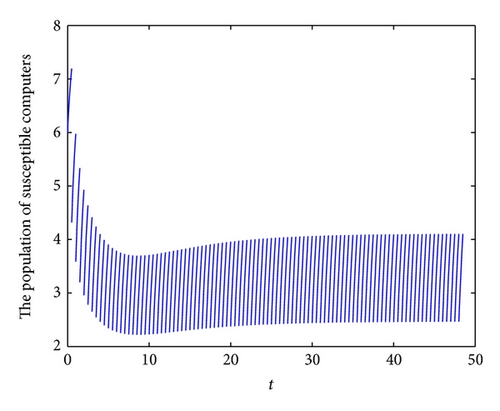
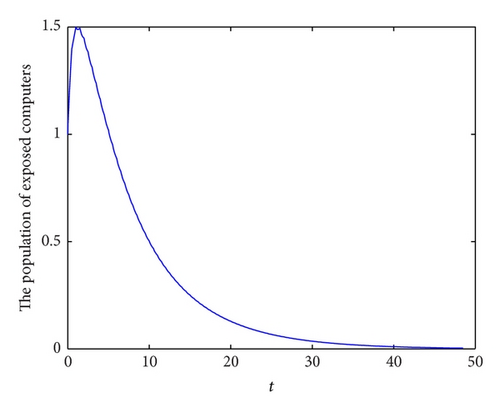
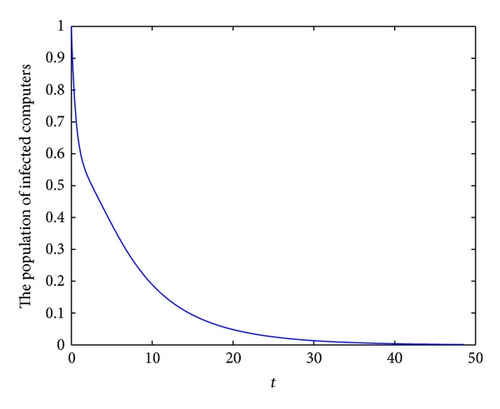
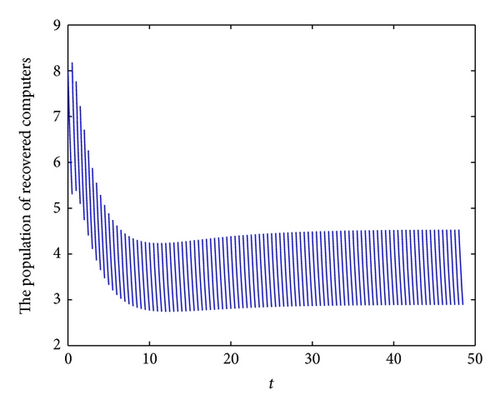
To demonstrate the permanence of system (6), we take the following set parameter values: b = 2.7, λ = 0.2, p = 0.1, q = 0.15, d = 0.3, ζ = 0.6, ε = 0.4, γ = 0.6, τ = 0.5, η = 0.3 and θ = 0.1. In this case, we have R1 = 1.6496 > 1. In Figures 4(a), 4(b), 4(c), and 4(d), we have displayed, respectively, the susceptible, exposed, infected, and recovered populations of system (6) with initial conditions: S(0) = 6, E(0) = 1, I(0) = 1 and R(0) = 8.
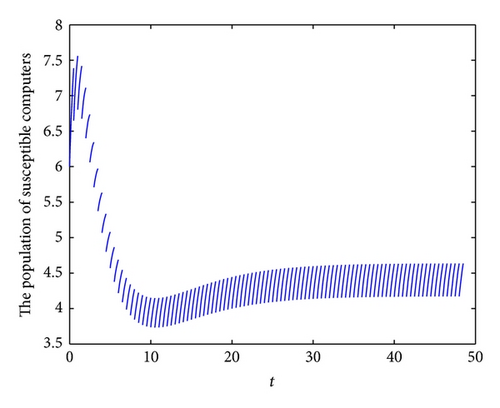
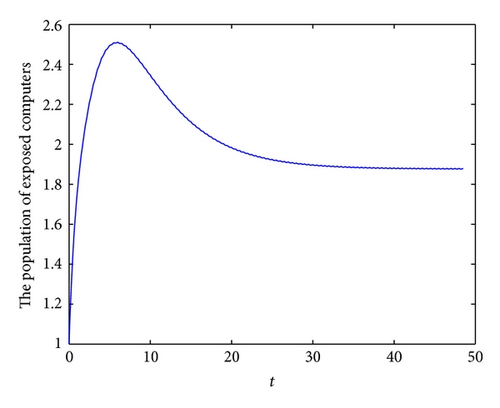
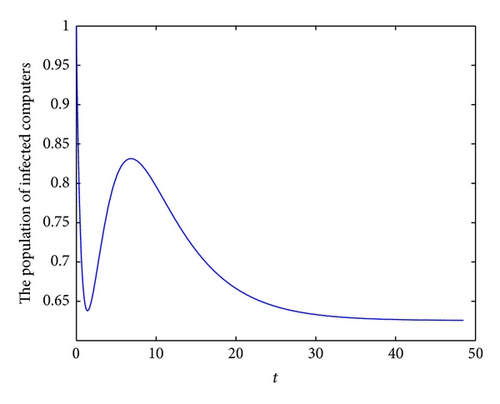
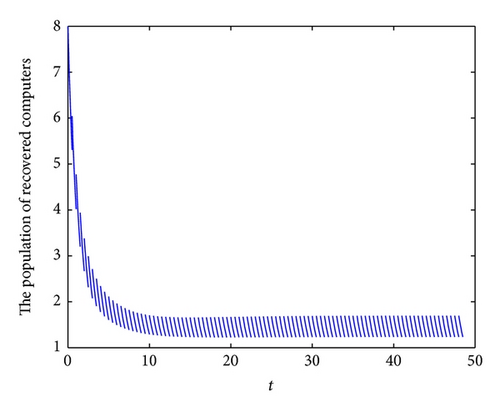
5. Conclusion
We have analyzed the SEIRS model with pulse vaccination and varying total population size. We have shown that R1 > 1 or θ < θ1 implies that the worm will be local, whereas R1 < 1 or θ > θ1 implies that the worm will fade out. We have also established sufficient condition for the permanence of the model. Our results indicate that a large pulse vaccination rate will lead to eradication of the worm.




